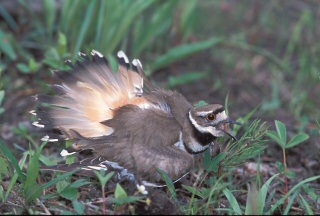|
Trail Guides
|
Rea Farm, "The Beanery"
|
5
 
|
Bayshore Road, West Cape May, NJ
The Rea Family (information about the site can be obtained at CMBO, Northwood Center (609) 884-2736)
Turn Right out of the Meadows
lot onto Sunset Blvd. Almost immediately turn Left onto CR 607/Bayshore Rd. After 0.6 miles, you will see two old silos on your left. After
the silos, turn Left into the grassy parking
area. Map
Open daily from dawn to dusk. Parking area on site. Access is restricted to NJA/CMBO members and pass holders. See below for further information.
Special note: In a financial arrangement unique in the birding world, New Jersey Audubon has leased the “birding rights” at Rea Farm for the use of its members. Visitors can obtain a pass and/or sticker at the CMBO's Northwood Center
in Cape May Point or Center for Research and Education in Goshen for a fee. The site has also undergone a transformation in the last several years with the removal of old farm machinery, as well as non-native invasive plants.
 |
| Adult Killdeer | Kevin Karlson |
| |
| | The Rea Farm (better known locally as “The Beanery”) is one of the premier sites for observing migrating birds in Cape May, which is high praise in a region abundant with migration hotspots. The site, which used to be a working lima bean farm, includes three connected fields surrounded by wet woods, and bordered with tractor paths. A small willow-lined pond is located at the east side of the property, and a defunct railroad track intersects the fields and swampy woods. The Beanery is centrally located on Cape Island, and is sheltered by surrounding belts of tall trees. As a result, it is often the warmest spot on Cape Island, causing migrants to linger along its sun-warmed hedgerows.
If the ponds are not frozen, interesting waterfowl such as Ring-necked Duck, and the occasional Eurasian Widgeon may be present. The open fields can also support flocks of pipits, larks, and sparrows. Winter is also the best time to see perched and calling Red-shouldered Hawk.
The Beanery is alive with migrant
sparrows, warblers, vireos, tanagers, and orioles.
A favorite among birders is the Prothonotary Warbler, several pairs of which nest on the
property and may be found from mid-April through late July. Later in spring, take
precautions against mosquitoes and ticks.
The primary attractions are the breeding Prothonotary Warblers. By late July, autumn songbird migration is underway, and is best observed early in the morning.
The open fields and wet woods provide ample habitat for a wide variety of migrating bird species, and the Beanery will be busy with songbirds and large flocks of sparrows. Look up, and you may see a kettle of raptors gathering in a thermal formed by rising warm air.
|
|
|